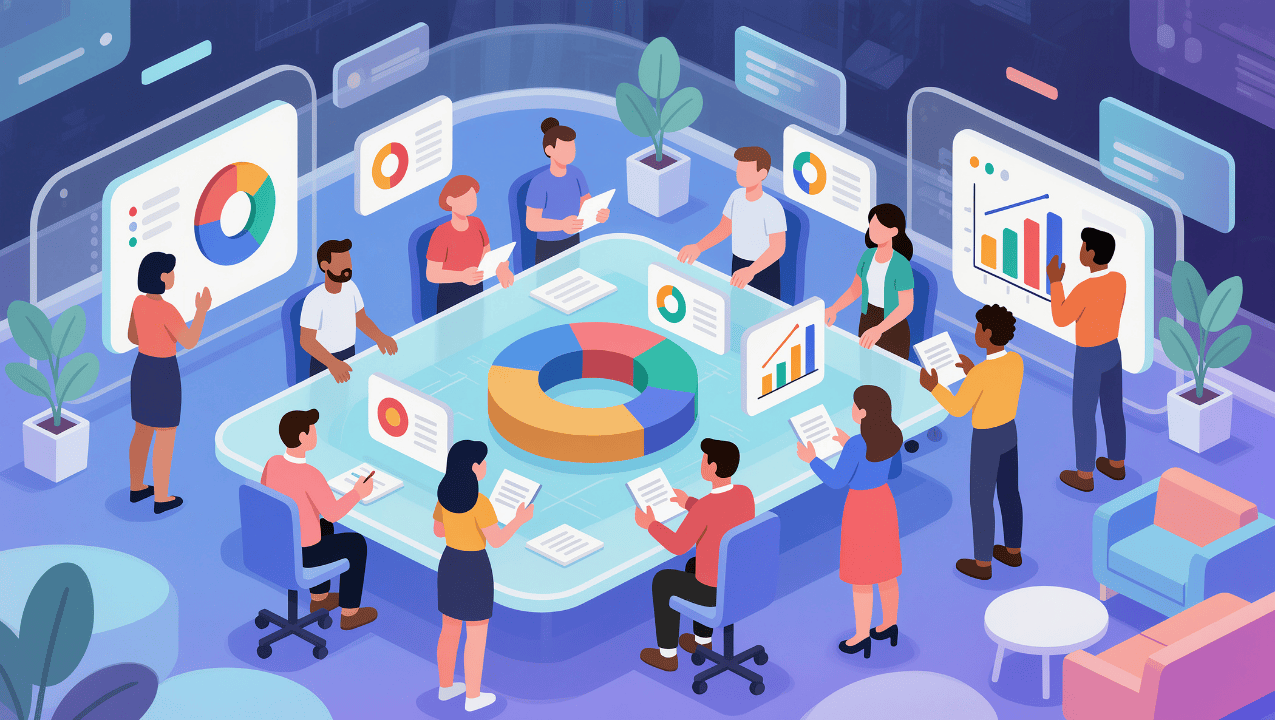Tue, 07 Oct 25
Why Visualization Changes the Way Leaders Decide
Where Strategy Meets Clarity

Why Visualization Changes the Way Leaders Decide
In a world flooded with data, decision-making has become both more informed and more complicated. Leaders today have access to dashboards, analytics tools, and real-time metrics that previous generations could not even imagine. Yet despite this abundance of information, many leaders still struggle to make decisions confidently and quickly.
The reason is simple. Data in its raw form does not speak to the human brain. Numbers alone rarely inspire clarity or conviction. What bridges the gap between information and action is visualization — the ability to see patterns, relationships, and trends that are otherwise hidden in spreadsheets or reports. Visualization transforms data from something leaders read into something they feel and understand instinctively.
The human brain is wired for visuals
Long before humans learned to read or calculate, we learned to see. Our brains evolved to process visual information far faster than words or numbers. Research shows that the human brain processes visuals about 60,000 times faster than text. Nearly 90 percent of the information transmitted to the brain is visual.
This means leaders are not naturally wired to interpret dense tables or static documents. They are wired to spot patterns, trends, and outliers visually. When data is visualized properly, it aligns with how our brains make sense of the world.
Visualization turns an abstract problem into something tangible. It helps leaders connect logic and intuition — allowing both analytical and creative thinking to work together. When a CEO sees a clear visual trend, such as customer churn spiking after a product change, the decision to investigate or adjust becomes obvious. The data ceases to be abstract; it becomes a story.
Visualization builds shared understanding
Leadership is not just about personal clarity; it is about alignment. A great leader must make others see what they see. This is where visualization becomes powerful — it creates a shared language of understanding across teams.
When data is presented visually, complex findings become accessible to everyone, regardless of their technical background. Instead of debating over spreadsheets or reports filled with jargon, teams can gather around a single visual narrative. This shared clarity reduces misinterpretation, speeds up consensus, and improves collaboration.
In fast-moving industries, alignment is everything. When everyone can literally see what is happening — whether it is a drop in engagement, a shift in market share, or a spike in customer satisfaction — teams act faster and more decisively. Visualization democratizes decision-making by making information visible, not just available.
From data to story: the emotional connection
Numbers inform decisions, but stories drive them. Visualization transforms raw data into stories that evoke emotion and context.
Consider a healthcare leader analyzing patient satisfaction scores. A spreadsheet shows a decline from 82 percent to 77 percent. It looks like a small drop — until that same data is shown on a heat map that highlights hospitals with severe satisfaction declines in red. Suddenly, the problem feels urgent.
This is what visualization does — it adds emotional weight to information. Humans respond more strongly to visuals because they trigger emotion alongside logic. A well-designed chart, dashboard, or infographic does not just show data; it helps leaders feel the impact of their decisions before they make them.
This emotional connection is vital in leadership. It transforms decision-making from a cold, mechanical process into one guided by empathy, foresight, and accountability.
Clarity in complexity
The modern business environment is noisy and complex. Leaders are constantly managing uncertainty — market shifts, consumer behavior, competition, and technology disruption. In such conditions, clarity is the greatest competitive advantage.
Visualization cuts through complexity by revealing what truly matters. Instead of drowning in thousands of data points, leaders can see clear cause-and-effect patterns.
For instance, a product manager viewing a visual funnel chart can instantly identify where customers are dropping off. A financial executive can quickly see which region or segment drives profitability. An HR leader can visualize engagement across departments and immediately see cultural gaps.
Visualization simplifies complexity without oversimplifying truth. It reduces cognitive load — the mental effort required to process information — allowing leaders to think more strategically and less reactively.
Visualization enhances prediction and foresight
Good leadership is not just about understanding the present. It is about predicting the future. Visualization helps leaders forecast scenarios and simulate outcomes in ways that static data cannot.
Predictive dashboards and visual models allow leaders to experiment safely. What happens if we raise prices by 5 percent? What if a supply chain delay extends by two weeks? Visualization lets leaders test these “what if” scenarios visually — making abstract forecasts more concrete.
This builds foresight and agility. Instead of waiting for problems to appear, leaders can anticipate them early and adapt quickly. In fast-moving markets, this predictive clarity often determines which organizations stay ahead and which fall behind.
The art of decision storytelling
Great leaders are also great storytellers. They know that decisions are not made in isolation — they must be communicated, justified, and championed. Visualization helps leaders tell those stories persuasively.
When a visual dashboard or chart is used in a board meeting, it becomes more than a presentation tool. It becomes a narrative device. It shows where the company has been, where it is now, and where it needs to go next.
Storytelling through visualization makes decisions stick. When team members understand the “why” behind a choice, they execute with more commitment and clarity.
Visualization also supports transparency. Instead of hiding behind complexity, leaders can show their reasoning openly, backed by visible data. This strengthens trust and credibility across the organization.
The psychology of faster decisions
Cognitive science shows that visuals accelerate decision-making by reducing friction. When leaders see data as a picture instead of reading it as text, they can process multiple dimensions of information simultaneously — trend, scale, correlation, and anomaly — all at once.
In high-pressure environments, this matters. Visualization speeds up comprehension, which shortens the time between insight and action.
For example, during a crisis, a supply chain dashboard can instantly show which regions are affected and where inventory is available. Instead of waiting for reports or analysis, leaders can make immediate, informed decisions.
Visualization transforms data into situational awareness. It helps leaders respond faster, not by guessing, but by seeing.
Beyond tools: the mindset shift
Visualization is not just a design technique or a data tool. It represents a shift in how leaders think about information. It moves decision-making from being data-driven to being insight-driven.
Being insight-driven means understanding that data is only valuable when it leads to clarity, alignment, and action. Visualization is the medium that makes this transformation possible.
For leaders, the goal is not to have the most data but to see the most clearly. Visualization trains the mind to look for connections, not just metrics. It encourages curiosity — prompting questions like “Why does this pattern exist?” or “What is driving this shift?”
The leaders who adopt this mindset make decisions with greater confidence because they are not reacting to isolated numbers. They are interpreting patterns, stories, and meaning.
Conclusion
Visualization is no longer a luxury of design-driven companies. It is a necessity for modern leadership. As the volume and complexity of data grow, leaders who rely on text-heavy reports will increasingly find themselves at a disadvantage.
Those who embrace visualization, on the other hand, will see faster, think clearer, and lead smarter. Visualization brings together logic and intuition, data and emotion, evidence and empathy. It transforms decision-making from an analytical task into a strategic craft.
At Blanc Research, we believe visualization is the next evolution of insight. It is not just about showing data beautifully — it is about helping leaders see differently and, in doing so, decide better.


